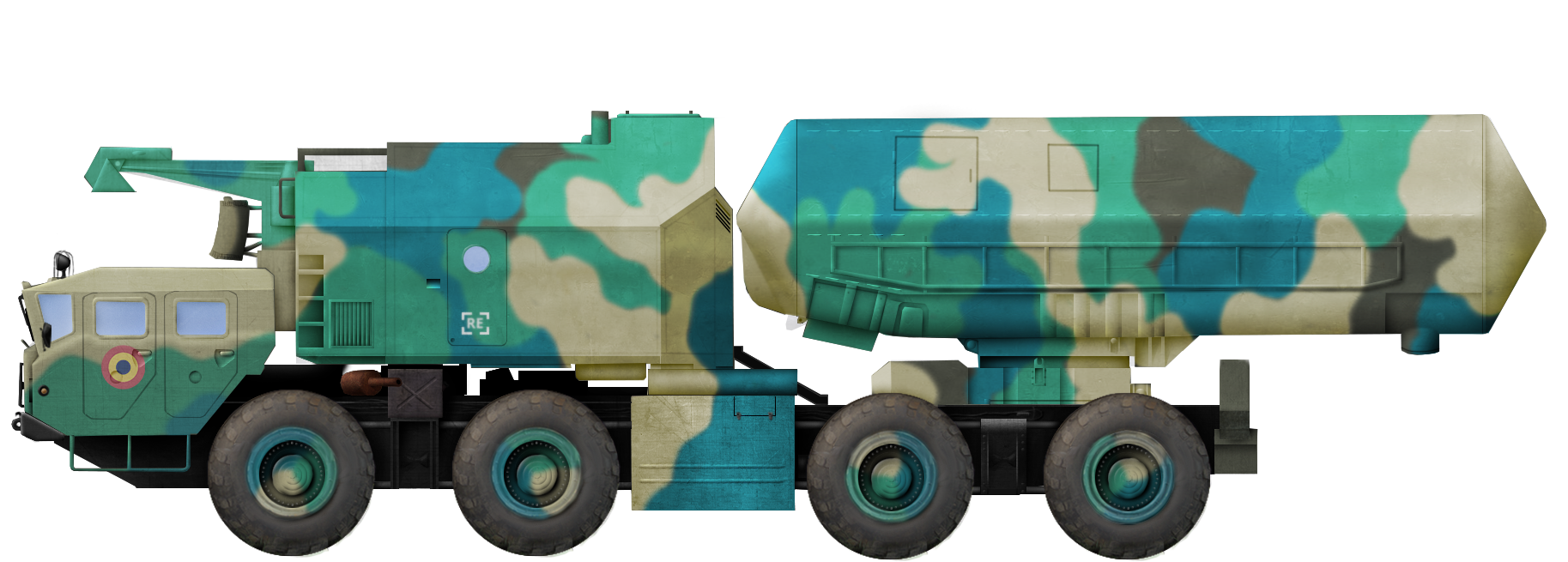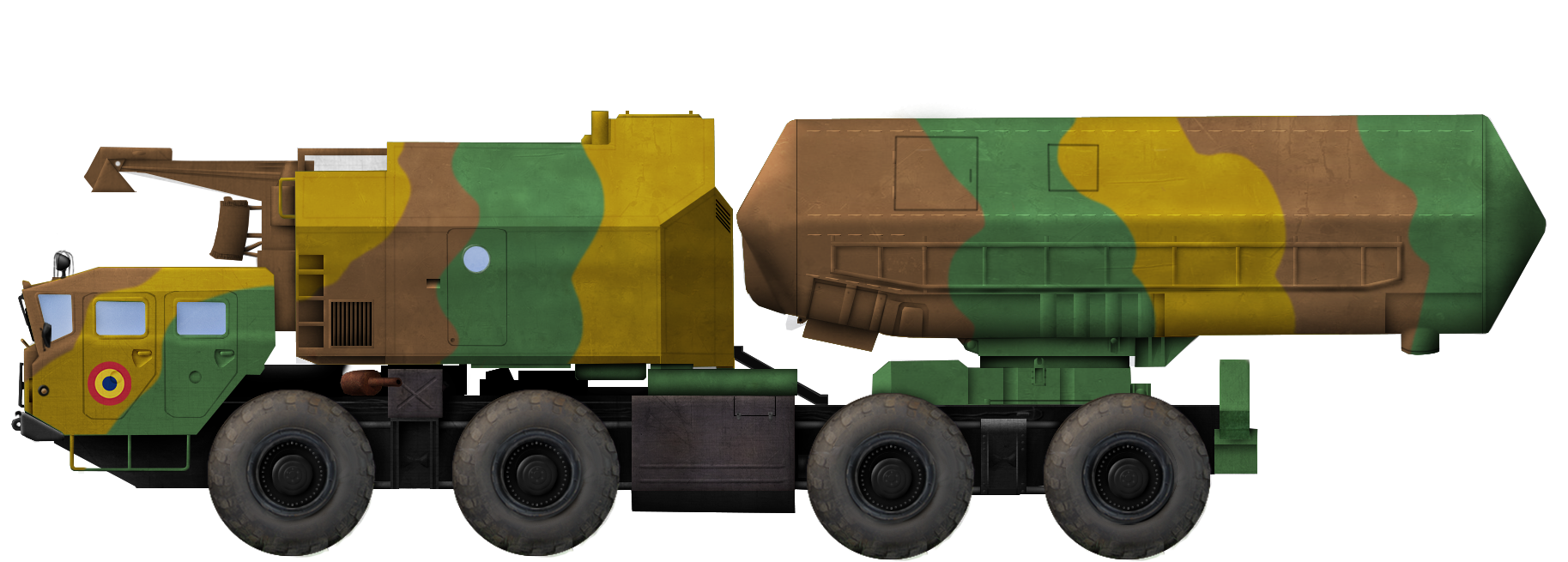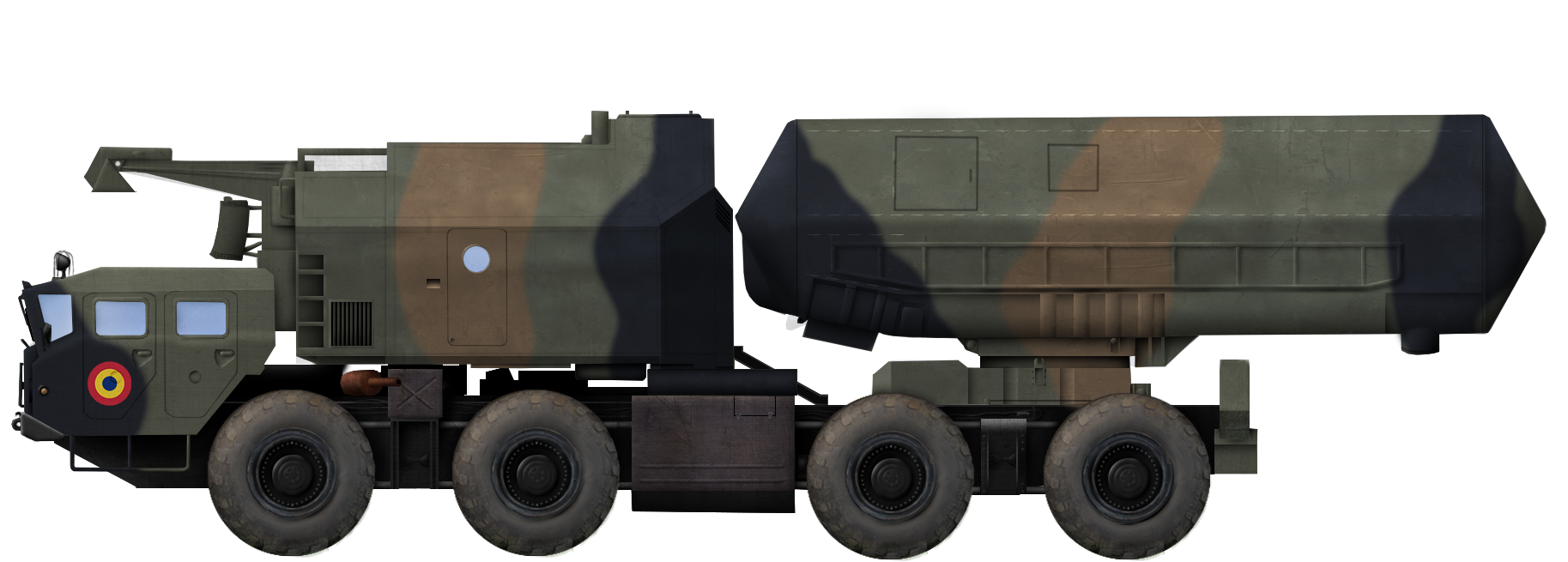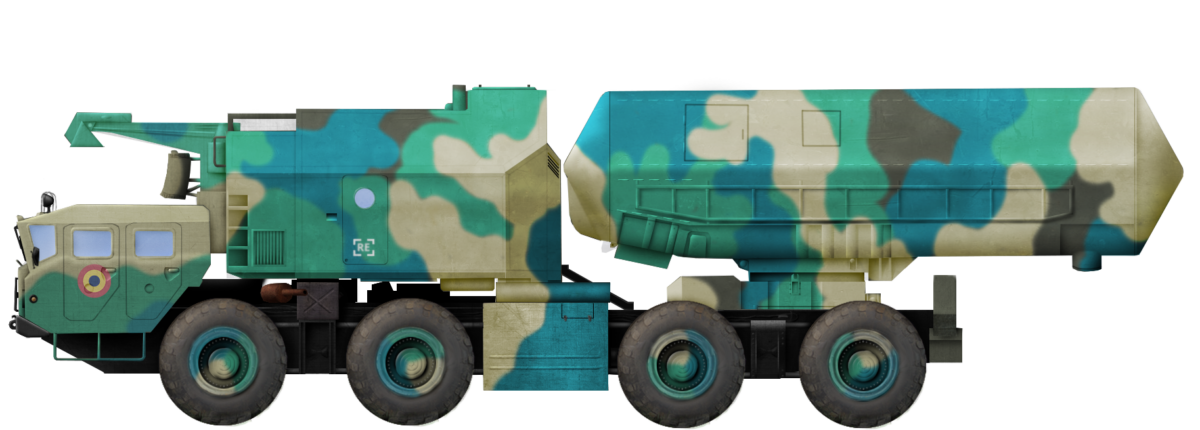
 Socialist Republic of Romania/Romania (1987-2024)
Socialist Republic of Romania/Romania (1987-2024)
Anti-Ship Coastal Defense Missile System – 4 Purchased
While Romania’s topography consists mainly of great plains crossed by the Carpathian mountain chain, Romania has an opening to the Black Sea stretching over 245 km. For centuries, this opening has proved crucial for the local population, offering a great trading route with nearby territories, and a connection with the Danube river. When the Romanian Communist Party started its wide scale industrialisation program in the 1960s, the opening to the Black Sea would become even more important, and would require serious defending, both via the sea, but also directly from land. The last piece of equipment purchased by the Socialist Republic of Romania for this role was the 4K51 Rubezh, a Soviet mobile coastal anti-ship missile system, that could provide cheap and fast defense against naval threats.

Source: MApN via Ștefan Ciocan
Background, the P-15 Termit in Romania
The Romanian re-armament plan of the 1960s consisted of purchasing a variety of modern Soviet equipment, most notably rockets and missiles. Such weapons became exponentially more important, offering immense destruction power, with short travel times and long ranges, with relative safety for the firing vehicle. One of these systems was the P-15 anti-ship missile, initially intended for ship-to-ship use.
In March of 1961, a delegation of the Romanian military was sent to Moscow to discuss the terms of the Warsaw treaty, as well as rearmament of the Romanian military. During this period, the acquisition of 6 Project 205 (Osa-class missile boats) for the Romanian Navy was decided, to be received in the period of 1962 and 1965. These ships were equipped with 4x P-15 Termit missiles each, and formed a brand new naval battalion. The new unit would be named the 133rd Vedete (Missile boat) battalion. A total of 5 Osa-class boats were imported in 1964, with several produced locally later on, the boats receiving the designation of NPR, Navă Purtătoare de Rachete (rocket carrying ship). The P-15 would be transported on land by SR-114 Bucegi trucks. The Romanian Frigate Mărășești also uses 4 P-15 launchers, with 2 launch tubes each.
The 4K51 Rubezh missile system was purchased in 1988 brand-new from the USSR, as Romania completely lacked a designated mobile coastal defense missile system, with only conventional artillery systems and the SA-N-2 Volhov stationary missile systems, which the Romanian military claims could also be used against naval targets. Just 4 systems were purchased and were delivered by March 1988. Interesting to note is that the systems have not undergone any sort of modification, either in the Soviet Union or Romania, and thus, all writing and information inside the vehicles are in Russian, in Cyrillic writing.

Colorized by Smaragd123
4K51 missile system
In the 1960s, the Soviets were analyzing their existing coastal-defense systems, the 4K87 Sopka and the 4K44B Redut. The Sopka was already obsolete, while the Redut, despite its supersonic cruise speed and long range, had a long fire preparation time and was simply too large. Additionally, it was not allowed for export. Thus, development started at the Raduga design bureau in 1970, with the Moscow Design Bureau of Mechanical Engineering designing the missile launcher, named 3S51 with KT-161 launch containers. The Design Bureau of the Minsk Automotive plant would undertake the necessary modifications for the chassis, based on their own 8×8 MAZ-543M truck. The 23-tonne truck used a 38.8 liter V-12 D12A-525A diesel, delivering 525 hp with 38,8 l and consuming 80 liters / 100 km (2.94 miles / gallon). It had an automatic gearbox and reached a top speed of circa 60 km/h. Fuel reserve was sufficient for 630 km.
The system consisted of 4 main components. The truck itself had the driver’s cab at the front, which was small in size in order to be able to fit the engine to the right. Behind was the telescopic radar. Behind it was the main control and firing cabin, which housed the crew of 6 men and all the FCS equipment and turbocharged power supply. Lastly, the two launching pods were mounted at the back, with a full 360° range. The launching of the missiles could only be done in a 110° range adjacent to the chassis, and the lowest elevation being 20°. Two lids, on both sides of the launcher tube, were opened automatically prior to launching.
The ZC51 Harpoon telescopic radar ensured the independence of the system, not requiring an external radar, though an extra long-range radar could be used (something Romania did not order for the Rubezh). The Harpoon radar had a range of 100 km and scanned the surface of the water level over this area. In tandem with the mobile 3S51 launchers, they ensured that the system was ready to fire in just 5 minutes, and could drive off even faster.
Testing of the vehicle began in late 1974, at the 141st independent Artillery Division, for which the 1267th Independent Coastal Missile Division was formed at the Black Sea. Firing tests were held at Cape Fiolent, in Crimea. A total of 23 launches were built between 1975 and 1977. It was adopted in service with the Soviet Navy on the 22nd October, 1978, after Decree from the Council of the Ministers of the USSR No. 853-875.
In the 1980s, a modernization was made, using an enlarged MAZ-543M truck. The launching system was named 3P51M.

Source: Bogdan Dinu
P-15M (P-21 & P-22)
The missile used on the 4K51 was the P-15M, which was an excessively modernized variant of the P-15 missile. It featured a trapezoidal wing, which was folded during transport in the vehicle, and would lock open after launch. Its empenagge consisted of a small vertical stabilizer and two horizontal stabilizers. Its propellant consisted of a two-stage rocket engine. The first engine was used at the initial launch and to reach the designated cruise altitude. Once it ran out of fuel, the cruise engine would start operating. The fuel used was the usual solid-state TG-02, in tandem with AK-20K nitric acid based oxidiser. The cruise engine was tasked with reaching a speed of 320 m/s (1,150 km/h) and maintaining it until it reached the target. During navigation, the rocket used an APR-25 autopilot, radio-based altimeter, navigational system and homing radar. The total range was thus increased to 80 km, at maximum cruise altitude of 250 m, but between 50 and 100 m above sea-level was recommended. It had a mass of 2,573 kg, out of which 513 kg was the conventional warhead. It was 6.565 m long, a wingspan of 2.4 m and a diameter of 0.76 meters. Each launcher had 2 different target acquisition systems, one with an active radar, while the other had a thermal infrared system. These missiles were sold internationally as the P-21 and P-22 respectively. The 2 target acquisition types offered crews flexibility in regards to what missile to launch, taking into consideration the target. Alternatively, firing both missiles ensured a higher chance of a hit, especially if the enemy vessel tried to jam the systems.

Source: Flacăra
Organization
On 30th of November 1987, as per the General Staff, the 460th Coastal Rocket Battery was formed, part of the garrison at Mangalia. The unit received all 4 systems by March 1988. First firing exercises were held on 18th of May, 1989, at the Tuzla firing range. On 30th of July, 1990, the unit changed name into the 508th Coastal Rocket battalion, and in 2005 it was integrated into the 190th Naval Rocket battalion. Since 2017, the 585th C.B.R.N. defense company is integrated into the 508th Coastal Rocket battalion.

Source: Unknown
Camouflage
After the original reception, these vehicles were painted in the standard dark green color and given a Romanian roundel on the door. During the 1990s, the vehicles were repainted in a 3-tone camouflage with light blue, light green and yellow over the base dark green coat, resulting in a flamboyant 4-tone camo. This was usual practice, as there was no camouflage norm set by the General Staff, so units would paint their vehicles with whatever paint was available, resulting in some interesting colors and patterns. Between 2007 and 2010, the vehicles were repainted again, this time in a 3-tone camo, with light green, yellow and brown. In 2017, with higher budgets to individual units and reorganization, the vehicles were painted to the standard NATO 3-tone camouflage with khaki, black, and brown.

Source: Ro Navy
Raytheon Replacement – NSM
There are rumors that, in the mid-2000s, the 4K51 and subsequent P-21 and P-22 missiles were to be taken out of service. Apparently, after a firing test, the missile destroyed the naval target on first hit, thus extending the service life of the missiles in Romania, both on the 4K51 but also for the ships that used it. Financial issues are the more probable reason behind this extension, but the Romanian Army loves its myths. After being in service with the Romanian Navy for over 30 years, the 4K51 system is showing its age. Even early in its life, the system was questioned for its relatively short range (not necessarily an issue for Romania’s moderately small coast) but, more importantly, interception of the missile and jamming of the guiding systems. Additionally, Romania’s stock of these missiles is getting smaller, to the point that firings of real rockets are not undertaken anymore.
Since 2017, the Ministry of Defense (MApN) has shown interest in replacing the 4K51 systems with the NSM, Naval Strike Missile, developed by Kongsberg Norway. A contract was signed in May 2021, worth €286 million. This consists of 4 mobile launcher systems, 1 mobile command & control center, 1 loading and transport vehicle, as well as all testing, logistical, maintenance and training aspects. The systems will be delivered in 2024.
The NSM is a light anti-ship missile, with a range of 185 km and weighing only 125 kg. It uses an infrared sensor to identify and guide itself to the target, which makes it hard to detect by radar and is classified as a ‘stealth’ missile that can be used all-weather.
Poland acquired the system in 2008, and the US adopted the system in 2018.
| Missile | P-15M | NSM |
|---|---|---|
| Dimensions (length – wingspan) | 6.565 – 2.4 m | 3.96 – 1.36 m |
| Mass | 2.573 kg | 407 kg |
| Warhead mass | 513 kg (conventional) | 125 kg |
| Cruising Speed | 320 m/s (1152 km/h) (716 mph) | 240 – 326 m/s (864 – 1173 km/h) |
| Cruising altitude (above sea level) | Recc. 50 – 100 m (max 250 m) | Sea-skimming (< 50 m) |
| Range | 80 km (50 miles) | 185 km (115 miles) |
| Target acquisition and homing system | Active radar (P-21) and thermal infrared (P-22) | Infrared imager, passive sensors, GPS |

Source: MApN Facebook



4K51 Rubezh missile system in Romanian service specifications |
|
| Dimensions (L-W-H) | 14.2 x 2.97 x 4 meters |
| Total Weight, Battle Ready | 40+ tonnes |
| Crew | 6 |
| Propulsion | D12A-525A diesel V-12 525 hp 38.8 l with 80 l/100 km consumption. |
| Speed | 60 km/h |
| Armament | 2x P-15M (P-21 & P-22) missiles, launched from the 3S51 with KT-161 launch containers. |
| Armor | N/A |
| Total Purchasedn | 4 launchers |
Sources
Forțele Navale Române (navy.ro)
TiV No.5 2021
Rachetele armatei române şi criza vectorilor nucleari sovietici trimişi în Cuba (1960-1963) | Contributors – Petre Opriș
Rachete balistice sovietice în România (1961-1998) | Contributors – Petre Opriș
https://www.hotnews.ro/stiri-defense-23117440-armele-romaniei-care-sunt-rachetele-sistemele-artilerie-din-arsenalul-militarilor-romani.htm – Victor Cozmei
OFICIAL Armata cumpără sisteme mobile cu rachete anti-navă NSM din SUA. Când vor fi livrate primele sisteme care vor păzi coasta Mării Negre – HotNews.ro – Victor Cozmei
Dotări noi la Forţele Navale Române. Rachetiştii se inst (cugetliber.ro) – Andreea Perhaiță
NSM – Naval Strike Missile – Missile Systems – KONGSBERG – Kongsberg Defence & Aerospace

